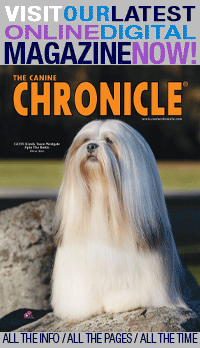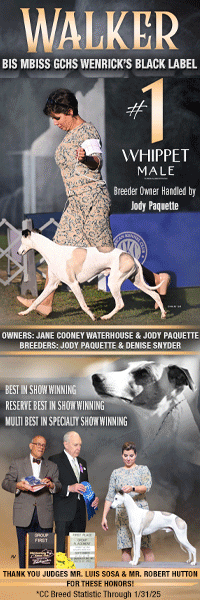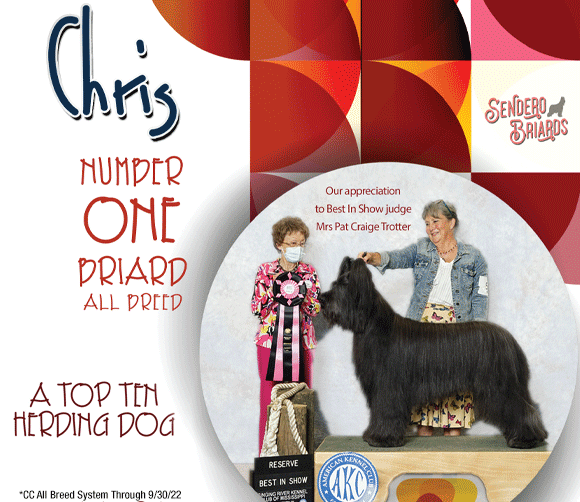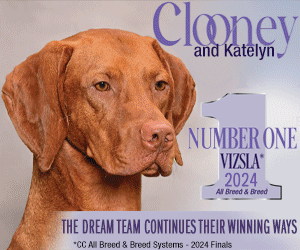From The CC Vault: The Dalmatian: What Should You Look For?
By Lisa Dubé Forman with Wendell Sammet
Originally published: June 2013
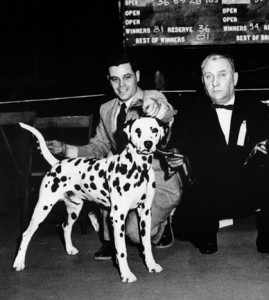
1953 WKC Judge Mr. Alfred W. Barrett · BOB Ch. Boot Black From Dalmatia shown by breeder/owner Wendell Sammet
This is the first introduction in a new series that I will be offering on The Canine Chronicle website. As educational series go, they will be valuable tutorials offered in a monthly succession placing individual breeds center stage. Rather than a Proust questionnaire, I present it as more of a discussion between myself and the interviewee. This month’s topic of discussion is the Coach Dog.
It has been my sincere pleasure to reach out to Mr. Wendell Sammet of Dalmatia Dalmatians. For those in need of introduction, Mr. Wendell Sammet began his dog career immediately after the Second World War in 1946 with a Dalmatian who in 1949, won the first New England Ten Mile Road Trial. During an era of notable prestige, his Dalmatian was Best of Breed at both the 1953 Westminster and Morris & Essex Kennel Club Shows. In 1956, a Dalmatian sired by Wendell’s 1953 stud dog had the great distinction of winning Best in Show at the last, original, Morris & Essex Kennel Club show. As the pièce de résistance of a tremendous breeding program, Wendell won the 1949, 1953, and 1954 Dalmatian Club of America National Specialties. My intent is not to fawn but rather I stress these accomplishments because they corroborate prodigious knowledge. In turn, this valuable reservoir of knowledge communicates the most meaningful particulars of the Coach Dog and of general canine anatomy. Two topics that are unfamiliar to many of today’s breed fanciers.
Envisage me and Wendell Sammet in the center of the ring, shoulder to shoulder, observing the Dalmatians in a lineup. His schooling begins with an important briefing on the history of the Dalmatian. He was an endurance watchdog traveling on foot for miles accompanying coaches to ward off thieves through thickly wooded roadways. In the evenings, while the travelers were sleeping these dogs were indispensable sentinels warning against thieves who otherwise might steal the coach horses and property.
The tutorial continues with the desire for a medium-sized, evenly spotted dog whose length is nearly equal to his height having equal proportion of length of leg as compared to the distance from elbow to top of withers. His neck is nicely arched and long enough to carry his head at ten o’clock (above is too high and below is too low). His topline is strong and smooth, the back level with a short muscled loin. He is a dog with muscularity having no presence of refinement or lumbar, sans any exaggerations such as too long a neck or overangulated hindquarters. The Dalmatian should not share the characteristics of a Labrador with the appearance of being low on leg, long in body, lumbering or overweight. Nor should the Dalmatian display the characteristics of a Pointer with a leggy appearance, a slanting topline and an underline curving too abruptly to the tuck-up, or should he have ticking and patches as seen on the Pointer.
All-inclusive, a dog whose structure is allied with running, one who should exude endurance possessing sufficient bone and is not ‘whippety.’ Either too refined or lumbering robs the body of durability and strength. The conformation of parts aid the running dog with each part blending and complimenting each other allowing for overall balance. He requires a deep chest to the elbow with the underline being of great importance. The sternum is well ribbed back with a gradual curving to the tuck-up allowing for excellent contraction of the diaphragm filling his lungs with air for the distances. Typically now seen in the ring are Dalmatians with too much tuck-up which reflects steep thorax’s, sloping toplines and a leggy Pointer appearance. A desired picture of a Dalmatian in motion illustrates steady and effortless movement, a dog of indefatigability. His reach extends no further than his nose, with a powerful drive from the rear coordinating with the reach. Today, we observe overextended fronts and high front action that of a parade pony.
The Dalmatians’ hindquarters require muscularity and a slightly bent stifle. Weaknesses frequently observed are straight angled stifles. Straight stifles have no follow through while driving as they push off but cannot fully straighten out because they lack angulation which inhibit the leg’s ability to thrust. Additionally and equally concerning are overangulated bend of stifles resulting in cow-hocks and or sickle hocks caused by incorrectly angled tibia and femurs.
An often overlooked but crucial aspect of this dog are the feet. These should be round, compact, with well-arched toes, however the feet are not that of a terrier. The rear feet are similarly shaped as the front for running. Feet are to have thick elastic pads which behave as a cushion supporting the toes and though Wendell does not recommend picking up feet, while in proximity a judge can distinguish flat feet which are typically accompanied by weak, thin pads. Correct, slightly angled pasterns denote flexibility in this endurance dog. Steep pasterns with buckled over toes and sloping pasterns with flat feet weaken staying power. Conversely, short, upright pasterns typically mirror the slope of the shoulder and denote inflexibility in this endurance dog. Feet facing east-west also are a hindrance. The Dalmatian stands four square and his weight should be distributed well over all four feet, especially the rear. While standing for examination, one should not observe pads showing on rear flat feet which is a major hindquarters construction fault, typically a result of short tendons and or unequal length of femur to tibia.
The Coach Dog’s head is a quality feature. Mr. Sammet desires one that is bold in appearance, with a flat skull that is as wide as long having a slight vertical furrow, well-defined stop and blended cheeks. In profile, the planes are parallel and of equal length. Frequently today, there are too coarse of heads with cheekiness, apple-domed skulls, dogs having little stop between the eyes and slight muzzles lacking strength and width. His ears are wide at the base tapering to a rounded tip, carried high and close to the head, except when alert, the top of the ear should be level with the skull. Unfortunately, today the preferred spotted ear has disappeared taken over by black ears. Beware the hound ear that is long and hangs low and the too small of an ear that sits away from the face and sits high. His eyes are of medium size, rounded in appearance, set well into the skull. Color of the eyes are either brown or blue, surrounded by complete pigment.
The most distinguishable characteristic of the Dalmatian is color and markings and the appearances of such are crucial to breed type. Moreover, Mr. Sammet advises that judges should observe and evaluate both sides of this breed because markings are very important. Dismayingly, the breed today is losing markings in general, as well as spotted ears, and hand painted dogs (an evenly marked dog). This is most likely due to today’s breeders considering conformation more important than the markings when both should be considered equally. Ideally, spots should appear to be a dime to a half dollar in size with face and leg markings smaller than the body markings. Today’s show ring displays a number of choices in markings that take away from the desired, ‘evenly spotted’ Dalmatian. These include dogs with a maximum of ten to twelve spots on a white background, or the Dalmatian with fairly decent markings but with areas of predominately large white ground color, even on occasion incorporating half the side of the dog. Also Dalmatians decently spotted but with many clusters of black spots and the Dalmatian with spotting on the body so intermingled, to the point that they are no longer distinct. The latter excessive intermingling of spots can affect breed type by eliminating ‘the evenly marked’ Dalmatian. There are Dalmatians with good conformation and undesirable markings and Dalmatians with mediocre conformation and good markings but the correct Dalmatian should have good conformation and good markings. Lastly, the coat texture of the Dalmatian is of great importance as he was an outdoors companion in all kinds of weather. The coat must repel rain and snow and should be short, dense and close fitting being neither woolly or silky.
Mr. Sammet concludes on temperament as that being a Dalmatian who must possess a stable, outgoing temperament. Indeed, temperament is of such importance that a Dalmatian displaying shyness should not be awarded.
Short URL: https://caninechronicle.com/?p=253065
Comments are closed
